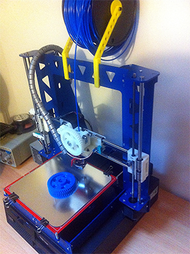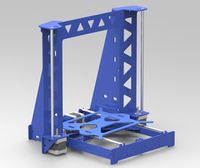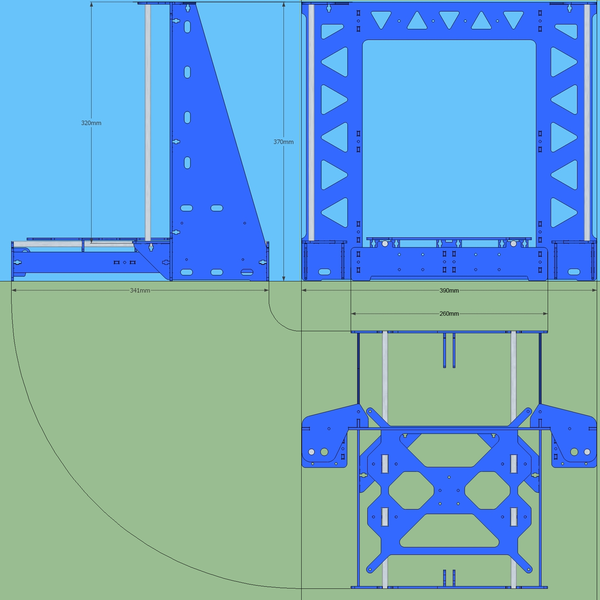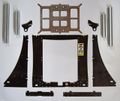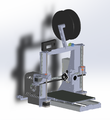P3Steel
|
English • العربية • български • català • čeština • Deutsch • Ελληνικά • español • فارسی • français • hrvatski • magyar • italiano • română • 日本語 • 한국어 • lietuvių • Nederlands • norsk • polski • português • русский • Türkçe • українська • 中文(中国大陆) • 中文(台灣) • עברית • azərbaycanca • |

Release status: working
| Description | Remix of Twelvepro's redesign of Josef Prusa's i3
|
| License | |
| Author | |
| Contributors | |
| Based-on | |
| Categories | |
| CAD Models | |
| External Link |
Contents
- 1 Introduction
- 2 Frame versions
- 2.1 Version 1.2 (by irobri)
- 2.2 Version 2.0 (by irobri)
- 2.3 Version 2.01 (by AndrewBCN)
- 2.4 Version 2.5 (by AndrewBCN)
- 2.5 Version 3.0 (By Ghosthawk)
- 2.6 Version 4.0 (By Alvaro Rey and Daniel Torres)
- 2.7 P3steel toolson edition (2.x plastic parts mod)
- 2.8 Version PROBOT (by Arturo René Echanique Torres, madrid3DPrint)
- 2.9 Version PROBOT All Steel (by inven.es)
- 3 P3Steel MGN V19 By 3DCampy / 3DEspana
- 4 Modification to use Spindles
- 5 Assembly manual
- 6 Where to buy
Introduction
The P3Steel is a remix of Twelvepro's redesign of Josef Prusa's i3.
Leonardo - the prototype P3Steel printer - was designed and built by Irobri in April 2013, after attending a local Maker show in Zaragoza, Spain.
The main frame structure, built from laser-cut 3mm steel, is extremely strong and simple to assemble, and eliminates the need for several printed parts due to the use of steel parts instead of threaded rods for the "Y" subframe (as in the original Prusa i3 and many of its variants).
- Steel as a building material has several advantages over e.g. aluminum
- Steel is one of the least expensive building materials available - structural steel is 10 times cheaper than aluminum.
- Laser cutting steel is easier and cheaper than cutting aluminum.
- Steel is stronger than aluminum.
- Disadvantages
- Steel is 3 times heavier than aluminum, although this could be considered both an advantage and a disadvantage, in the sense that a heavier frame does not tend to vibrate as much as a lighter frame. Also, if we consider the total weight of the printer, the difference between an aluminum frame and a comparable steel frame is not that much (around 2.5kg extra).
- Structural (carbon) steel requires painting or galvanizing for protection against corrosion. Stainless steel, of course, does not require painting.
The P3Steel design is for 3mm thick steel and with lots of carvings to reduce weight. All square holes and tabs have special rounded corners for accommodating corresponding parts and give a very good fit between parts.
The design has slots for M3 nuts in the places where the screws fit so no threading is required.
Improvements over the standard Prusa i3
- Stronger frame due to the use of structural steel.
- Solves the frame flexing thanks to its reinforcement squares.
- Simplifies the construction, eliminating the complex subframe of threaded rods in the Y-axis.
- Once assembled, everything is in place, no adjustments needed.
- Eliminates the need for several printed parts.
- The steel mounts for motors and rods are much stronger than their plastic counterparts.
- The only two threaded rods needed are the ones for the Z-axis (5mm).
- Uses shorter smooth rods lowering the build costs.
- Once assembled, it forms a compact, solid structural unit that can be transported as a block.
Main dimensions (frame version 2.0)
Frame versions
The P3Steel frame design has evolved since it release. There are various versions.
Version 1.2 (by irobri)
Leonardo, original printer, made by irobri in October 2013.
Source files
Version 2.0 (by irobri)
After some requests from a Spanish group building around 30 printers, irobri have modified the bed, now it holds with 4 LM8UU instead of 3 and it has also a system to level with 3 points instead of the original 4, it should be easier with this new design. I kept the original 4 points also just in case someone still wants to use them. I included in the gallery some 3D renders of the new bed. The rest of the printer is exactly the same as version 1.2
Everything snaps together and holds with M3x12 screws (mainly), irobri also used nylon self locking nuts to prevent future problems due to vibration.
The printer uses 8mm chromed smooth rods (Z axis: 2 x 320mm, Y axis: 2 x 341mm and X axis: 2 x 375mm) and only two M5 threaded rods (295mm approx. each since depends on motor coupling and if you want some to stick out through the top) for the Z axis, printed parts required came from a standard Prusa i3, you only need the parts for the X axis assembly and the extruder.
The printer structure is assembled quite fast and needs no adjustments. The electronics are installed on either side of the frame, horizontally, holes provided are for an Arduino mega and RAMPS 1.4. Motors are NEMA 17, GT2 pulleys, LM8UU and 608zz bearings. Hotend is budas type, but depending on the extruder plastic parts, will also accommodate J-head and E3D hotends. The hotbed is the standard MK2B.
Version 2.01 (by AndrewBCN)
This is exactly the same as version 2.0 except for the changes listed below.
Changed from 2.0
- The interference between the Y stepper and the M3 nyloc nut holding the Y stepper support has been solved by stretching the support by 2mm (see the P3Steel Y axis assembly page for details).
- The frame has been stretched by 9mm, meaning the Y-axis 8mm smooth rods should now be 350mm long (same as the original Prusa i3), and not 341mm long anymore (4mm have been added to the front and 5mm to the back).
- Two 3mm holes have been added along the sides of the front Y-axis subframe, one on each side, to attach optional accessories / cable ties to the frame.
- The practically useless part that could eventually be used as a Y belt holder has been deleted (there are much better designs that can simply be printed).
Justification
(see the Discussion tab for justification of these changes)
Source files
- File:PRUSA i3 steel 3mm lasercut 2.01d irobri.dwg (DraftSight 2014 and higher, compatible with recent version of SolidWorks)
Version 2.5 (by AndrewBCN)
This is a dual Bowden extruder capable, slightly enlarged P3Steel variant derived from my earlier P3Steel 2.01 variant. In keeping with the KISS philosophy of the original P3Steel and avoiding changing something that works, as few changes as possible were made in relation to version 2.01:
- The frame is 10mm wider. This is achieved by making the central plate and the two Y-axis end plates 10mm wider. Note that the distance between the Y-axis smooth rods remains the same..
- The frame is 10mm taller. This is achieved by making the central plate and the two side panels 10mm taller.
- The holes to mount the Arduino Mega 2560 + RAMPS board are 10mm higher, increasing the clearance for the USB cable.
- There is an added cutout in each of the side panels to keep the frame weight in the same range as the original P3Steel 2.01.
- There are two stepper motor cutouts, one on each side panel, for mounting two optional Bowden extruders.
- All screw holes now have the same diameter, 3.2mm (the holes for the electronics on the side panels were previously specified at 2.6mm diameter for later tapping with M3 threads, this is now deprecated).
Apart from the minor changes above, nothing else is changed.
Note that making the printer 10mm wider and 10mm taller does not really result in an increase in the print envelope, rather it makes it easier to achieve the original print envelope of the Prusa i3 (200 x 200 x 200mm or 8l).
Also note that use of the Bowden extruder stepper mounts is optional. Basically the P3Steel 2.5 DXL can still be built exactly like the original P3Steel, with a single Greg's Wade's Geared Extruder on the X-carriage, or one can use a single Bowden extruder mounted on either sidepanel, or two Bowden extruders mounted on both sidepanels.
(see the Discussion tab for justification of these changes)
Source files
CAD file for version 2.5 (zipped): File:PRUSA i3 steel 3mm lasercut 2.5DXL e irobri.dwg.zip (generated with DraftSight 2014, use a recent version of DraftSight or SolidWorks to open)
Version 3.0 (By Ghosthawk)
Versions 3.0 and 4.0 mentioned below are not derived from either versions 2.01 or 2.5, they are independent developments by their respective authors.
Version 4.0 (By Alvaro Rey and Daniel Torres)
This version derived from Version 3.0 (By Ghosthawk) with the listed changes
- The extruder no longer hits the Z axis top bracket
- Y axis belt tensioner ( that may be placed printed or metallic )
- Weight reduction cutting as much material as possible
- Holes to bolt to the PSU
- Electronics as high as possible so that the cables are well hidden LCD
- Holes in the top bracket of the Z axis to position bearing
- Holes in the top bracket of the Z axis to place spool holder
- Axis movable to lose the least footprint
- Y axis bed it's suitable to install 20x20 heated beds or 20x30 heated beds
- The hole for the motor connector has been enlarged , allowing install engines below 70 OZ
- Bed with option for 3 or 4 bearings
- Bed with choice of 4 or 3 leveling points
- Holes for Zip ties was added to the main frame
The Y-Axis rods have been changed, now uses 10mm rods ans LM10UU lineal Bearing We recomended use aluminum beds for y axis.
We test aluminum frame too in 3mm. It works just the same
20x30 Frame - the Y-axis 10mm smooth rods should now be 510mm long
This version use aluminum beds, in orther to reduce weight in Y-Axis
P3steel toolson edition (2.x plastic parts mod)
The P3steel toolson edition uses the unmodified steel parts from a unmodified P3Steel v2.01 or v2.5 frame, but nearly every 3d printed plastic part has been improved:
- "P3steel - toolson edition" discussion on the RepRap forums
- "P3steel - toolson edition" on Thingiverse
P3steel toolson edition MK2
The successor of version 1. X and Y axis are equipped with sinterbronze bearing for best print quality, printer lifetime and extreme low noise level.
- "P3steel - toolson edition MK2" on toolson's blog
- "P3steel - toolson edition MK2" discussion on the german RepRap subforums
Version PROBOT (by Arturo René Echanique Torres, madrid3DPrint)
This version of P3Steel bets on a totally different design, looking for simplicity.
- It allows both the placement of beds 20x20 and 30x20 by means of two pieces of steel that extend the base for the bed of 20x20.
- The bobbin holder is integrated in the structure and does not protrude.
- A steel tensioner has been designed on the Y-axis which simplifies the tedious tensioning of the belt on this shaft in P3Steel.
- The filament holder is so wide that it allows the placement of two coils simultaneously.
Files DWG and DXF
https://drive.google.com/open?id=0B_Da6EGfd1Wzc0N0NFdBNndsSUE https://drive.google.com/file/d/0B_Da6EGfd1WzMWhHcG00eWhvZVU/view?usp=sharing
Printed piece (spacer) to be placed on the tensioner Y
https://drive.google.com/open?id=0B_Da6EGfd1WzU3hwV0VQbW9JZ0E
Image
https://drive.google.com/open?id=0B_Da6EGfd1WzWWNXMGhnUkNZUGM
Version PROBOT All Steel (by inven.es)
In collaboration with Arturo, we have started from its PROBOT version including the improvements developed by Claudio (revolucion3D), to develop the P3Steel PROBOT All METAL model. Trying to improve the obsolescence of the 3d maker printer by eliminating all plastic structural parts we have also improved the stability when printing at high speeds.
The improvements provided by this version:
- Improves obsolescence of the structure by not carrying plastic parts.
- The printer has no vibration during printing at high speeds, improving the quality of the parts.
- An X-axis tensioner is included in the structure.
- Calibration becomes easier with the X and Z axis calibration screws.
- A complete assembly and calibration manual has been developed in Spanish.
List of parts PROBOT All Metal
List of rod PROBOT All Metal
Image of the printer PROBOT All Metal
- http://inven.es/img/probot.png
- http://inven.es/1007-thickbox_default/inven-3d-kit-impresora-3d-probot.jpg
P3Steel MGN V19 By 3DCampy / 3DEspana
Designed by 3DCampy and with a year of development I have the pleasure of presenting my P3steel MGN project
The logical evolution of the P3steel, I have taken care of the all details so that everything fits perfectly and the esthetic is as clean as possible
This is my wiki with all change log WIKI
The new P3steel V19 is designed for the most demanding users, the movement of all axes is by linear guides, which provides structural rigidity and extraordinary precision.
After the development and many hours of testing, the P3steel MGN V19 is a platform that has been tested and proven, and we are improving day by day with small improvements.
For little money you will have at your disposal a professional, robust and durable desktop printer.
- Compatibilities
- Compatible with Titan aero extruder
- Compatible with BMG Bondtech extruder
- Compatible with MKS Gen L electronic -Marlin 1.1.8-
- Compatible with SKR 1.3 electronic -Marlin 2.0-
- Compatible with Duet 3D electronic
- Compatible with MKS Mini 12864 LCD
- Compatible with Mini12864 RGB LCD
SOURCE FILES Video: https://youtu.be/ORBLZrMCv2k
Modification to use Spindles
To use 10mm diameter spindles we need to separate the smooth rod and the spindle, leaving room for the nut and bearing parts in the X axis. Therefore some adaptation is required. We have designed a few pieces for use them in the original structure, so the changes were minimal.
This file File:Adaptacion Husillos.zip contains the OpenSCAD design files along with some other files to support for visualizing the set.
Assembly manual
Text
- Assembly PDF: File:Montaje PSteel.pdf
- Online manual: Complete assembly manual online
- Assembly step by step 3DEspana.com Wiki with photos - P3Steel Pro
Video
Assembly animation
Where to buy
Frames and kits
Warning, many people do not receive their order from Orballo Printing. Avoid this website.
- 3DEspana.com P3steel MGN V19 2019 Version
- HTA3D frame from 59€, kits too. Spain.
- Orballo Printing p3steel v2.5 and p3steel v4 from 50€, Spain.
- CREATEC 3D kits from 75€, kits from 395€, Spain.
- INVEN: V2.5 frame from 76€ (out of stock), kits from 300€, Spain.
Kits only
- HTA3D Full kit for P3Steel from 367€, 20x20x21cm actual printing volume, direct drive extruder with Mk8 and hotend V6, cable chain and much more. Spain.
- IBEROBOTICS Shop - Complete kit from 409€. Optional assembly service. Spain.
- iFusionShop, kits from 434€. Spain.
| Proyecto Clone Wars |
License
While the authors of this derivative work claim the licence to be CC BY-NC-SA, the original Prusa i3 was released under GPL v3. The GPL (all versions) oblige all derivative work or ensemble containing material under GPL to also be licensed under GPL -§5.c)- . This is the 'viral' part of the GPL.
So, modifying the license and adding restriction is not permitted and the license of all derivative remains GPL. This is unavoidable and as the work is already published, the authors cannot go back even if removing documents, which may be rightly republished by others under the real licence - with all attributions -.
Related
- The P3Steel is not to be confused with the 3Done P3.
